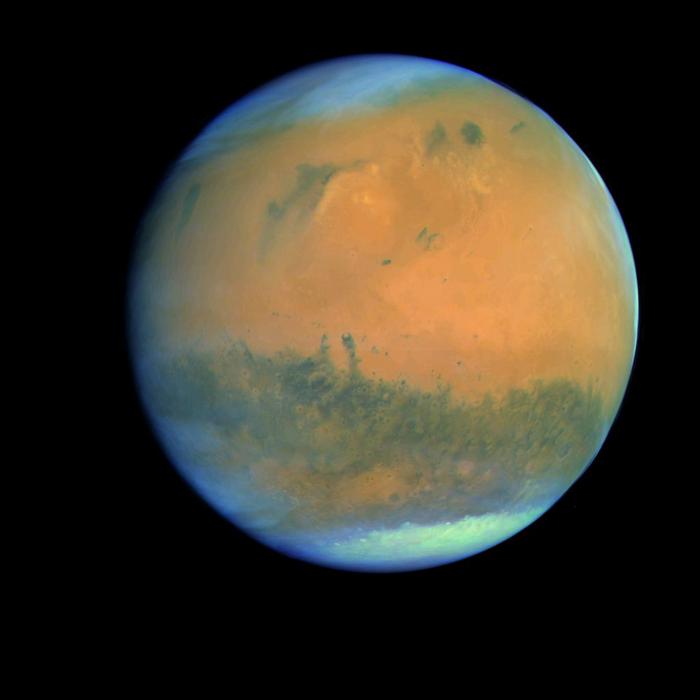
Why Is Mars Red? There's a New Story Behind the Red Planet's Coloring
www.discovermagazine.com
The full disc of Mars is seen with the polar ice caps slightly off centre to the top left and bottom right. Clouds wrap around the planets curved horizons. Dark surface markings are clearly seen against the characteristic red tones of the dusty martian surface. (Credit: ESA & MPS for OSIRIS Team MPS/UPD/LAM/IAA/RSSD/INTA/UPM/DASP/IDA, 2007/Shutterstock)NewsletterSign up for our email newsletter for the latest science newsThe story of the red planet, it turns out, may be due for a revision. At one time, experts thought that Mars was covered with fields of rocks with iron trapped inside. Somehow or other, and over a long period, those rocks reacted to water in the air. That reaction formed rust, in much the same way it does when iron and water meet on Earth. Then, over billions of years, those rocks slowly eroded. As they broke down into dust, heavy winds spread the scarlet silty substance all around, until Mars entire surface was coated with it. But a new study in Nature Communications instead says that water covered much perhaps all of its surface. That liquid quickly reacted to the iron in the planets many rocks. As the water receded, then disappeared, those rocks turned into dust, which then covered the entire planet."One of the most exciting aspects of this research was how it contradicted the prevailing theory about Mars' red coloration," says Adomas Valantinas, an author of the paper who participated in the study while at the University of Bern in Switzerland. He is now a research fellow at Brown University in the U.S.Origins of the Red ColorGraphic showing how Mars turned from a grey, wet planet into a dusty red planet. From left to right, four steps are illustrated in a single image. First, iron in the planets rocks react with oxygen and water to create rust. Then the rust is washed into rivers, lakes and seas, and becomes incorporated in the underlying rocks. A volcano is also shown to represent a heat source that may have melted ice, further washing the rust into pools. Over billions of years the rusty rock is broken down into dust. Finally, winds blow the dust around the planet. A rover is shown on the surface, representing the direct analyses of this rusty dust. An orbiting spacecraft surveys the scene from above. (Credit: ESA)Which version is correct has profound implications to astrophysicists and to anyone pondering whether life could have existed on the planet. That fact that water and iron form rust or iron oxide, chemically speaking is not up for debate. But there are many kinds of rust, formed by different chemical processes. Knowing which reactions happened at what point of the planets life can provide a lot of information.Earlier observations did not have much to work with. Images from spacecraft passing by the planet did not conclusively show any evidence of water within it. Researchers studying those images decided that the particular flavor of iron oxide must be hematite, which is formed under dry surface conditions with reactions to moisture in the planets atmosphere.However, combining newer observations of the planet with some laboratory experiments led some scientists to a different conclusion. The scientists decided that the planets red color more closely matches that of iron oxides containing water, called ferrihydrite. That version of rust typically forms quickly in cool water. Therefore the rust must have been created when the planet still had water on its surface, they report in the new study.Making Mars Rust on EarthA disc of orange-terracotta coloured dust fills the frame. The dust looks quite soft and fine, more like flour than sand. (Credit: A.Valantinas)To lend credence to that theory, some scientists decided to reproduce the watery birth version of Mars rust in an Earthbound laboratory. They essentially tried to replicate various scenarios by using different types of iron oxide.The scientists created the lab version of Mars dust with a sophisticated grinding machine that could produce grains as small as 1/100th of a human hair. They then compared their samples to images of dust collected by spacecraft orbiting the planet."While scientists had long thought the reddish hue came from hematite, a waterless form of rust, our research showed it actually comes from ferrihydrite, a water-containing rusty mineral," says Valantinas.Life on MarsHowever, there is only one way to conclusively prove if the early water theory of Mars dust creation is true: the return of actual dust samples from Mars. NASA has already collected such samples, and both the European Space Agency and NASA have upcoming missions that will collect more.Some of the samples already collected by NASAs Perseverance rover and awaiting return to Earth include dust; once we get these precious samples into the lab, well be able to measure exactly how much ferrihydrite the dust contains, and what this means for our understanding of the history of water and the possibility for life on Mars, Colin Wilson, an ESA scientist said in a press release.Only then will we really know which Mars dust story is just so.Article SourcesOur writers at Discovermagazine.com use peer-reviewed studies and high-quality sources for our articles, and our editors review for scientific accuracy and editorial standards. Review the sources used below for this article:Nature Communications. Detection of ferrihydrite in Martian red dust records ancient cold and wet conditions on MarsBefore joining Discover Magazine, Paul Smaglik spent over 20 years as a science journalist, specializing in U.S. life science policy and global scientific career issues. He began his career in newspapers, but switched to scientific magazines. His work has appeared in publications including Science News, Science, Nature, and Scientific American.1 free article leftWant More? Get unlimited access for as low as $1.99/monthSubscribeAlready a subscriber?Register or Log In1 free articleSubscribeWant more?Keep reading for as low as $1.99!SubscribeAlready a subscriber?Register or Log In
0 Kommentare
·0 Anteile
·58 Ansichten


